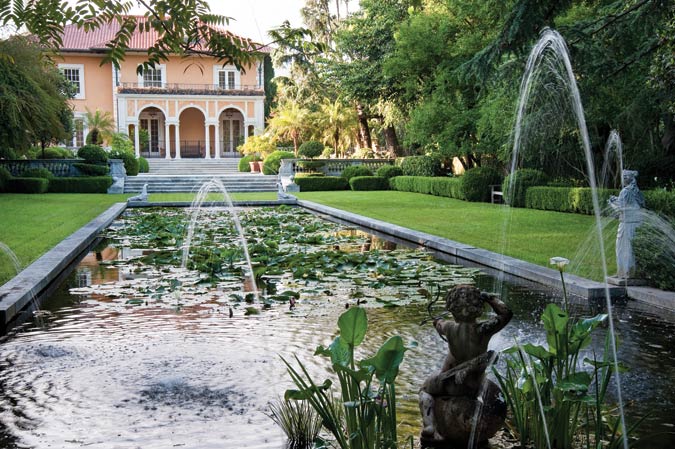
Classic Homes of Los Angeles
Douglas Woods; Introduction by D.J. Waldie; Photographs by Melba Levick
Rizzoli, $55.00
Sometimes a title is enough to throw you off a book. As you sink deeper and deeper into the lush interiors of the homes in Classic Homes of Los Angeles, you get stuck wondering what classic means. One thing it must mean is money, and gobs of it. The kind of money that, in the years just before and after World War I, easily bought you 8,000 square feet outfitted in Tiffany skylights, antique Moorish lanterns, fluted marble columns and, in what surely was the mark of civilization back then, a lot of hand-carved walnut library paneling. All of that, it seems, adds up to “classic.”
It’s a pleasure to thumb through these postcards from the city’s Gilded Age while sneaking a peak at how those who’ve still got money groom their material surroundings. The houses, shot by photographer Melba Levick, are resplendent, warm, and glowing like an open hearth. They are, with a few exceptions, built to a human scale. And there’s no question that the 25 homes that made the list are among the finest examples of the city’s embrace of “everything goes”—from half-timbered and Italian Renaissance Revival to Arts & Crafts and Spanish Colonial. If nothing else, these homes prove you can illuminate your pink moiré wallpaper in the dappled light of a crystal French chandelier even when the adjacent room is adorned with a torch lamp worthy of the Tower of London. As D.J. Waldie says in his introduction, the homes “put romance at the service of a new way of living.”
|
The oval ballroom at Charles Plummer’s 1921 Petitfils-Boos House, Hancock Park (left) and George Washington Smith’s 1926 Prindle House, Pasadena (right).
|
||
Waldie is asking us, in a way, to suspend our disbelief. These homes, and the thousands of others they inspired throughout Southern California, are not confections, he insists. “What makes a classic home of Los Angeles?” Waldie asks. “A house that can dream for and with its owners, that can dream of both escape and shelter.” Accept them for what they are, as part of a Los Angeles in search of itself. Then you will be at ease, able to appreciate their inherent beauty. Under their spell, you might also see the pentimento, obscured in the hand-troweled plaster and hand-hammered iron, of a self-conscious cadre in search of a civilizing standard. Then, as now, architecture, like fashion, was a social barometer.
Still the book is, essentially, a set of ready-for-House-Beautiful portraits of a number of familiar homes. Many we’ve seen before. The works of men such as George Washington Smith, Wallace Neff, Paul Williams, and Stiles Clement are well documented and well photographed, as are the lives of most of their clients. We already know these houses are “classics” because we’ve already explored them.
Maybe it’s the law of unintended consequences—by presenting a survey and staying largely on the surface, Woods places the reader in the mindset of Nathanael West in Day of the Locust: “Only dynamite would be of any use against the Mexican ranch houses, Samoan huts, Mediterranean villas, Egyptian and Japanese temples, Swiss chalets, Tudor cottages, and every possible combination of these styles.” D.J. Waldie attributes this view to a pompous Easterner dismissing the false spectacle of Los Angeles. But when you come to know the place, you come to dislike the way in which the kind of architecture represented by Classic Homes has become a cannon of authenticity and a staple of civic continuity, as if the past were a settled affair and the walls were incapable of telling the more bilious and bumptious story of the city. The odd thing is, if Classic Homes had dispensed with myth and stuck to reality, the architecture hiding behind all the gewgaws and imports would really have shone through.